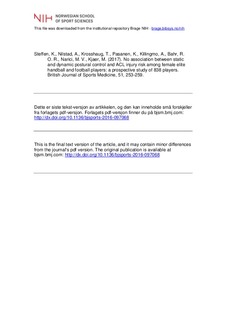| dc.contributor.author | Steffen, Kathrin | |
| dc.contributor.author | Nilstad, Agnethe | |
| dc.contributor.author | Krosshaug, Tron | |
| dc.contributor.author | Pasanen, Kati | |
| dc.contributor.author | Killingmo, Aleksander | |
| dc.contributor.author | Bahr, Roald | |
| dc.date.accessioned | 2017-05-08T08:53:14Z | |
| dc.date.available | 2017-05-08T08:53:14Z | |
| dc.date.issued | 2017 | |
| dc.identifier.citation | British Journal of Sports Medicine. 2017, 51, 253-259 | nb_NO |
| dc.identifier.uri | http://hdl.handle.net/11250/2441857 | |
| dc.description | I Brage finner du siste tekst-versjon av artikkelen, og den kan inneholde ubetydelige forskjeller fra forlagets pdf-versjon. Forlagets pdf-versjon finner du på bjsm.bmj.com / In Brage you'll find the final text version of the article, and it may contain insignificant differences from the journal's pdf version. The definitive version is available at bjsm.bmj.com | |
| dc.description.abstract | Background: Research on balance measures as potential risk factors for ACL injury is limited. Objective: To assess whether postural control was associated with an increased risk for ACL injuries in female elite handball and football players. Method: Premier league players were tested in the preseason and followed prospectively for ACL injury risk from 2007 through 2015. At baseline, we recorded player emographics, playing experience, ACL and ankle injury history. We measured centre of pressure velocity in single-leg stabilisation tests and reach distances in the Star Excursion Balance Test. To examine the stability of postural control measures over time, we examined their short-term and long-term reproducibility. We generated logistic regression models, 1 for each of the proposed risk factors. Results: A total of 55 (6.6%) out of 838 players (age 21±4 years; height 170±6 cm; body mass 66±8 kg) sustained a non-contact ACL injury after baseline testing (1.8±1.8 years). When comparing normalised balance measures between injured and uninjured players in univariate analyses, none of the variables were statistically associated with ACL injury risk. Short-term and long-term reproducibility of the selected variables was poor. Players with a previous ACL injury had a 3-fold higher risk of sustaining a new ACL injury compared with previously uninjured players (OR 2.9, CI 1.4 to 5.7). Conclusions: None of postural control measures examined were associated with increased ACL injury risk among female elite handball and football players. Hence, as measured in the current investigation, the variables included cannot be used to predict ACL injury risk. | nb_NO |
| dc.language.iso | eng | nb_NO |
| dc.publisher | BMJ | nb_NO |
| dc.subject | ACL | nb_NO |
| dc.subject | football | nb_NO |
| dc.subject | handball | nb_NO |
| dc.subject | injury prevention | nb_NO |
| dc.subject | risk factor | nb_NO |
| dc.title | No association between static and dynamic postural control and ACL injury risk among female elite handball and football players: a prospective study of 838 players | nb_NO |
| dc.type | Journal article | nb_NO |
| dc.type | Peer reviewed | nb_NO |
| dc.subject.nsi | VDP::Samfunnsvitenskap: 200::Samfunnsvitenskapelige idrettsfag: 330::Andre idrettsfag: 339 | nb_NO |
| dc.source.journal | British Journal of Sports Medicine | nb_NO |
| dc.identifier.doi | 10.1136/bjsports-2016-097068 | |
| dc.description.localcode | Seksjon for idrettsmedisinske fag / Department of Sports Medicine | nb_NO |
